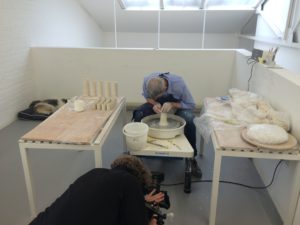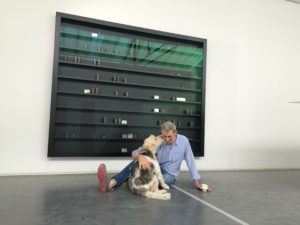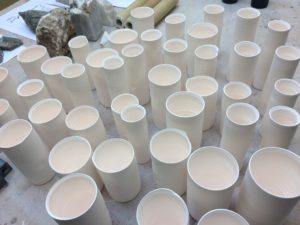 IM: Hi Edmund, thank you for letting us be here in your studio. you come here in the morning, sit down at your wheel and begin to work. Everybody who wants to talk to you comes here too, while you are throwing your pots. Do you always have a special programme, when you start here in the morning?
IM: Hi Edmund, thank you for letting us be here in your studio. you come here in the morning, sit down at your wheel and begin to work. Everybody who wants to talk to you comes here too, while you are throwing your pots. Do you always have a special programme, when you start here in the morning?
EDW: Where we are, as you can see, it is a very simple and very small space and it is not much here, apart from my wheel and some water, my cup of tee and my dog and some walls, where I actually write some ideas down. And here i have 50 maybe 60 very small bowls of white clay. It is porcelain clay from Limoges, which is a very beautiful clay. And what I am making is a series of vessels, very small vessels for an installation that I am making, for later this year. And making things that are very small and fiddly is kind of annoing. If something is bigger, you breathe more, but if something is small it is kind of restraining…
IM: But it was your decision, wasn’t it?
EDW: Yes, but i need dozens of these. Imagine lots and lots and lots of them. In black. These will be black pots. You will see them later in the kiln, lots of different black glazes; beautiful, beautiful dense black glazes. To get that kind of density, these shadows, you have to have lots of them; you cant have one, you need lots. So, this is my morning.
IM: That is what I wanted to talk about: it is not the one object you are interested in, it is the rythm of different objects put together in a certain space.
EDW: It is the rythm of different objects, its the repetition, that allows you to build up whole sequences of different ….repeted phrases. It is a bit like music; so far you can see, there’s not much music here, it is just three little pots….. (laughs) But when you have lots of them, you can begin a kind of cadence, rhythm and repetition … and of course the thing you can do with lots of pots is you can have gaps, you can begin to use the space between the objects to make it more dynamic.
When you first came to the studio this morning I was playing a Corelli, some early baroque music, and the reason why I was playing that was that I was getting in the thinking about very complex repeated rythms, that is what you get in baroque music. In baroque music you have that one theme that is repeated and repeated in different ways.
IM: When did you discover that you want to make objects, and not focusing on the single object, but on the composition of it.
EDW: I have always loved “making” more than one – i have always enjoyed repetition, i have always enjoyed returning to something and doing it again. But it took me quite a long time as an artist, as a potter, to work out that I was allowed to do that.
I was in Japan and in my late 20ies, early 30ies, and I came back to England and I thought, I really got to change, I really got to change! I really have to try this out, this idea of repetition – of the group.
Because I have been in Japan and even China – I was thinking about these great cargos with like shiploads of porcelain, so I called my very first installation “Cargo” – conceived to be like this great transition of porcelain from the east to the west. So the first thing I did, was making “Cargos” – and that was the beginning of it. So the beginning to make cargos of porcelain. And then gradually finding different ways of holding those installation of porcelains together; beginning with things on plints and then moving into things on shelfs, and then in vitrines, and then in architecture, in objects. And every time it changed it seemed the idea what vessels could do, became more and more interesting to me and closer and closer in some ways to writing.
When they are arranged these vessels became – when they are arranged in vitrines – closer to poetry, closer to music – i have been making groups, installations now for a good twenty … I am too old to remember … for a long time! and it just gets more interesting to me as I go on.
IM: And it is not about perfection? what you are working on, right?
EDW: It is so not about perfection!! I mean. The idea of the perfect vessel is sterile, its totally boring, its inane its banal. Whats interesting is the humanity of objects. Its the fact that they are made at their best within the movements, the breathing, slightly mis-shapen and the odd ways we move and feel in the world, so this is a good example, this object I am making here, because I am so interested in this question, this object is a bit wonky at the top. But actually, when you see this when it is finally finished and glazed as part of an installation, it will work really well. You know I could choose to through that away, I could choose to try and make it perfect, but – so far, this morning, that is my star-pot.
But one of the odd things working with this material – we may get to thite later – but this white material is, – culturally porcelain has always been seen as a perfect material. is been seen as a material which incorporates purity, incorporates magical properties of a substance which is nor clay, nor glass, nor gemstone has a kind of in between quality of it. And something you can make very expensive and precious and perfect vessels from. It has historically been all those things, but it has its other life, where things have gone wrong; a material which has been, which has been of desaster and complexity and mistakes and perhaps thats the history that makes me interested.
IM: Working with this fantastic porcelain, making objects with it – is it also much about virtuosity? the virtuosity of the potter? who wants to show, what he is able to do?
EDW: Well, this is such a problematic area, because when you want something which is really dull, you look to skill. When you want something that is really inert, dead, you look for the person who wants to show their skill. And the reality is that the most interesting things, things that make feel most alive in the world are these artists and musicians who have totally incorporated and forgotten their skills. And on the edge of play, on the edge of actually enjoying some process of discovery for themselves, which is not about showing off to some CRO prints or collectal – God help us – commercial, commodified world what you can do. I am huge believer in learning skills, as an apprentist in a very oldfashioned way and I don’t decry skill. But the showing off of skill is deadly.
The thing for me is: this I just love, you know: what is not to love? It is monday morning, it is raining outside and I got several hours of picking up clay and making vessels.
IM: What about your passion for white?
EDW: On one level it is a bit strange to me. When I was five I persuaded my dad to take me to an evening in the surroundings and I made my first pot on a wheel, which I loved – I loved making. And when the teacher next week said, you can glaze it, you can paint it any colour you want, I was five years old, and I chose no purples or yellows or reds, or blues or all these other glazes, and I made it white. I chose white. So there was a very strong impulse even as a child to make things white. So of course it has changed its emotional meaning, philosophical meaning to me so many times in those almost 50 years. But some of them …. I have many, many meanings of white: making something white makes you to look at it with more attention; it sort of isolates it; it brings it into focus, so making a white object for me is about slowing the well down a bit; concentrate with more attention on this odd thing; this odd white experience.
Working with white, white clay, and of course as a writer working with the white page, are very close to me too, because, for both experiences, because I said, a monday morning beginning with white clay, on another monday morning I could be sitting there in my library with just a white piece of paper….It’s about beginnings; its about beginning to look again at something. Think something over. And of course you can’t begin again – we know that. It gives a kind of moment of starting, which I think is really interesting.
This is spectacullary wrong! wonderful. really good one!
So white, my white, because it beginns, allows attention, is close to silence. and silence is fascinating. White is also obviously dangerous and difficult, it can be erasured, rubbing out something; it can be in whitewashing, removing something, all kind of other emotional and intellecutal things as well. You want to list the best white things in the world, I mean, from a cistercian medieval building to a corean moon jar to a Robert Ryman painting, to Malevichs white square to a page of porcelains poetry just a few lines, to an empty page to Moby Dick, the white whale to a camellia in spring to all these extraordinary attemps to look at snow, to Wallace Stevens poems – where do you want to go with white?! to porcelain.
IM: It is the colour of possibilities, right?
EDW: It is a colour of possibilities – it is also wonderfully it is not “a colour” it’s many, many, many things…..so it is not singular. That is something that slightly make me move my eyebrows, when people say to me: why don’t you use colour? with some kind of hostility: why don’t you use colour? And I go: well, here I am in a studio and I’ve got hundret different white glazes and tones, and tonalities, opacity, translucence and every time the white changes those whites change dramatically. They become different.
I had a wonderful opportunity last autumn to curate an exhibition with my favourite white objects here at the Royal Academy in London. What I did was to chose around 40 paintings, pieces of sculpture, books, and then i put them within a library in the Royal Academy. So they were with books. And then I took away all the labels, so that there was no label attached to the object we gave people a sheet of paper, they could go around and they had to find the things by themselves. And then because it was in a library it was totally silent; it was a silent exhibition. No labels – no talking at you, and no sound in the space. 21.30 And in that exhibition I had a Cy Twombly sculpture and I had a Malevich and I had Morandi, Robert Ryman, Agnes Martin, Joseph Albers – early photography, Sugimotos fotografs, I had my heir with amber eyes, my little ivory, I had texts by Samuel Beckett, some of my own work, some Renaissance marbles, and some very beautiful fragments of sculpture from the romanesque, I had an Ai Weiwei marble. And you know, it was really effective. It really worked, as an exploration of what white means. And I think it worked, because it slowed everyone down. So maybe thats what white can do. its to just slow down, because all of this was exploration by different artists and poets, sculpturers of whiteness. But there was no narrative there. Every single thing was different. So that is part of what my answer could be.

